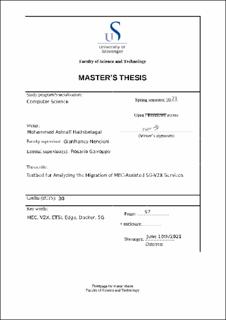Testbed for Analyzing the Migration of MEC-Assisted 5G-V2X Services
Master thesis
Permanent lenke
https://hdl.handle.net/11250/2786156Utgivelsesdato
2021Metadata
Vis full innførselSamlinger
- Studentoppgaver (TN-IDE) [835]
Sammendrag
With the advent of 5th generation mobile networks (5G), the automotive industry can manufacture vehicles that are capable of communicating not only with each other, but also with everything else around them using an ultra-reliable communication channel that offers high data rates and extremely low latencies. This allows the development of applications that can offer advanced features such as autonomous navigation, remote driving, non-line-of-sight awareness, and vehicle platooning. Such applications are expected to leverage the Multi-Access Edge Computing (MEC) paradigm and support User Equipment (UE) mobility.
In this thesis, a testbed was built to compare three different strategies for migrating three different MEC applications offering V2X services under two different network conditions. The applications were containerized using Docker and were capable of communicating with the ETSI MEC sandbox using the recommended open APIs it exposed. The three strategies were compared based on viability, service downtime observed, and amount of state preserved after the migration.
The results obtained from this testbed showed that that all the three strategies were viable. But there was also a very obvious trade-off to make in any migration scenario: either decrease service downtime or decrease the amount of state preserved after the migration. This meant that applications that needed a high level of user or application-specific state preservation tended to experience more service downtime.
